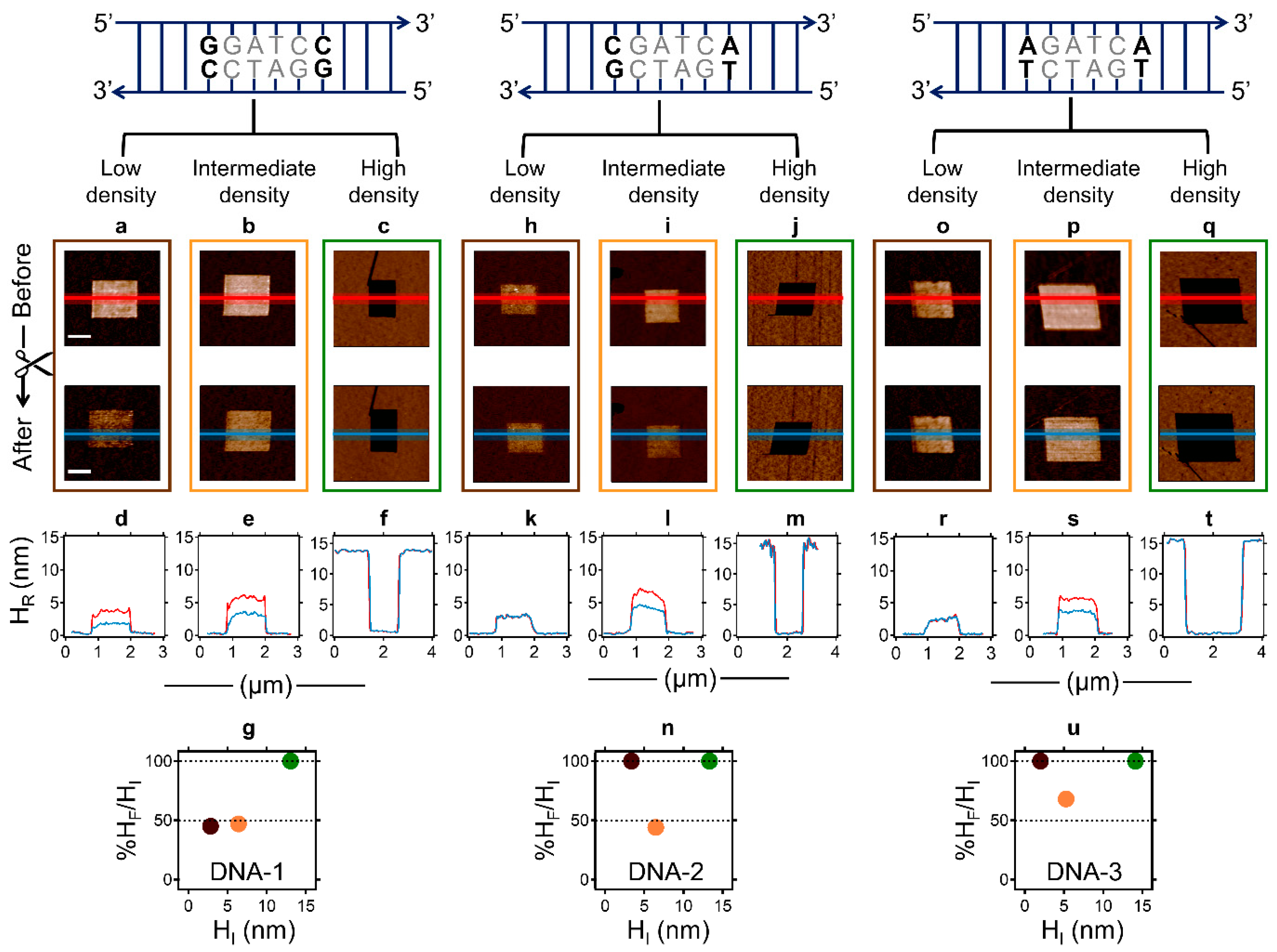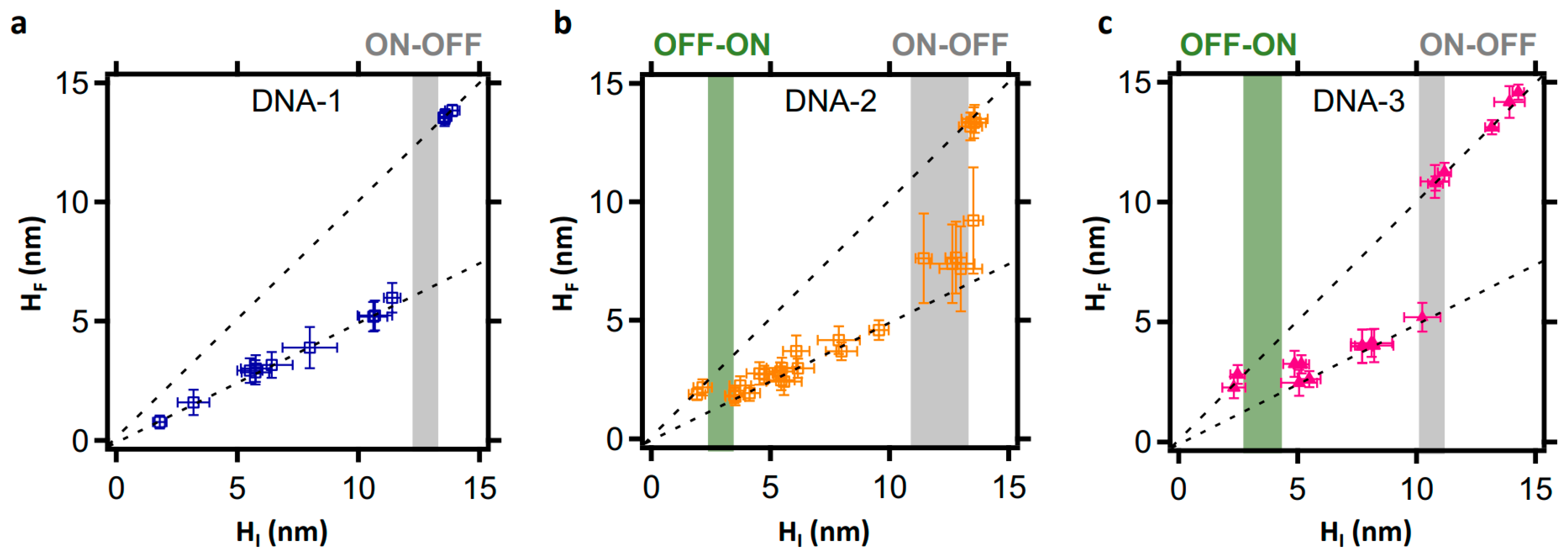Noncanonical DNA Cleavage by BamHI Endonuclease in Laterally Confined DNA Monolayers Is a Step Function of DNA Density and Sequence
Abstract
1. Introduction
2. Results
2.1. Design, Fabrication, and AFM Analysis of Surface-Bound, Laterally Confined DNA Monolayers (LCDMs)
2.2. Noncanonical DNA Cleavage by BamHI within LCDMs
2.3. Factors Controlling Noncanonical BamHI Action in LCDMs
2.4. Effect of LCDM Heterogeneity on BamHI Noncanonical Action
3. Discussion and Conclusions
4. Materials and Methods
4.1. Materials
4.2. DNA Sequence Design
| DNA Molecule | Sequence |
|---|---|
| DNA-1 | SH-((CH)2)6-5′-CAAAACAGCAGCAATCCAAGGATCCGACACCCGATTACAAATGC-3′ |
| DNA-2 | SH-((CH)2)6-5′-CAAAACAGCAGCAATCCAACGATCAGACACCCGATTACAAATGC-3′ |
| DNA-3 | SH-((CH)2)6-5′-CAAAACAGCAGCAATCCAAAGATCAGACACCCGATTACAAATGC-3′ |
| Complementary sequences | |
| cDNA-1 | 5′-GCATTTGTAATCGGGTGTCGGATCCTTGGATTGCTGCTGTTTTG-3′ |
| cDNA-2 | 5′-GCATTTGTAATCGGGTGTCTGATCGTTGGATTGCTGCTGTTTTG-3′ |
| cDNA-3 | 5′-GCATTTGTAATCGGGTGTCTGATCTTTGGATTGCTGCTGTTTTG-3′ |
4.3. Preparation of Ultra-Flat Gold Substrate
4.4. Preparation of Top-Oligo-Ethylene-Glycol SAM on Ultra-Flat Gold Substrate
5. Approach 1: Generation of Laterally Confined DNA Monolayers by ssDNA Nanografting
6. AFM Nanografting and Imaging
7. Approach 2: Self-Assembled Double-Stranded DNA Monolayer Formation
8. AFM Measurements
9. Restriction Enzyme Reaction
Supplementary Materials
Author Contributions
Funding
Institutional Review Board Statement
Informed Consent Statement
Data Availability Statement
Acknowledgments
Conflicts of Interest
References
- Roberts, R.J. How restriction enzymes became the workhorses of molecular biology. Proc. Natl. Acad. Sci. USA 2005, 102, 5905–5908. [Google Scholar] [CrossRef] [PubMed]
- Pingoud, A.; Jeltsch, A. Structure and function of type II restriction endonucleases. Nucleic Acids Res. 2001, 29, 3705–3727. [Google Scholar] [CrossRef] [PubMed]
- Wei, H.; Therrien, C.; Blanchard, A.; Guan, S.; Zhu, Z. The Fidelity Index provides a systematic quantitation of star activity of DNA restriction endonucleases. Nucleic Acids Res. 2008, 36, e50. [Google Scholar] [CrossRef] [PubMed]
- Kamps-Hughes, N.; Quimby, A.; Zhu, Z.; Johnson, E.A. Massively parallel characterization of restriction endonucleases. Nucleic Acids Res. 2013, 41, e119. [Google Scholar] [CrossRef] [PubMed]
- Miljkovic, M.; Malesevic, M.; Filipic, B.; Vukotic, G.; Kojic, M. Lra I from Lactococcus raffinolactis BGTRK10-1, an Isoschizomer of Eco RI, Exhibits Ion Concentration-Dependent Specific Star Activity. BioMed Res. Int. 2018, 2018, 5657085. [Google Scholar] [CrossRef]
- Krefft, D.; Papkov, A.; Prusinowski, M.; Zylicz-Stachula, A.; Skowron, P.M. Randomized DNA libraries construction tool: A new 3-bp ‘frequent cutter’ TthHB27I/sinefungin endonuclease with chemically-induced specificity. BMC Genom. 2018, 19, 361. [Google Scholar] [CrossRef]
- Zebrowska, J.; Jezewska-Frackowiak, J.; Wieczerzak, E.; Kasprzykowski, F.; Zylicz-Stachula, A.; Skowron, P.M. Novel parameter describing restriction endonucleases: Secondary-Cognate-Specificity and chemical stimulation of TsoI leading to substrate specificity change. Appl. Microbiol. Biotechnol. 2019, 103, 3439–3451. [Google Scholar] [CrossRef]
- Vanamee, É.S.; Viadiu, H.; Chan, S.-H.; Ummat, A.; Hartline, A.M.; Xu, S.-Y.; Aggarwal, A.K. Asymmetric DNA recognition by the OkrAI endonuclease, an isoschizomer of BamHI. Nucleic Acids Res. 2010, 39, 712–719. [Google Scholar] [CrossRef][Green Version]
- Seeman, N.C.; Sleiman, H.F. DNA nanotechnology. Nat. Rev. Mater. 2017, 3, 17068. [Google Scholar] [CrossRef]
- Hu, Y.; Niemeyer, C.M. From DNA Nanotechnology to Material Systems Engineering. Adv. Mater. 2019, 31, 1806294. [Google Scholar] [CrossRef]
- Bracha, D.; Karzbrun, E.; Daube, S.S.; Bar-Ziv, R.H. Emergent properties of dense DNA phases toward artificial biosystems on a surface. Acc. Chem. Res. 2014, 47, 1912–1921. [Google Scholar] [CrossRef]
- Redhu, S.K.; Castronovo, M.; Nicholson, A.W. Digital imprinting of RNA recognition and processing on a self-assembled nucleic acid matrix. Sci. Rep. 2013, 3, 1–9. [Google Scholar] [CrossRef]
- Castronovo, M.; Lucesoli, A.; Parisse, P.; Kurnikova, A.; Malhotra, A.; Grassi, M.; Grassi, G.; Scaggiante, B.; Casalis, L.; Scoles, G. Two-dimensional enzyme diffusion in laterally confined DNA monolayers. Nat. Commun. 2011, 2, 1–10. [Google Scholar] [CrossRef]
- Karzbrun, E.; Tayar, A.M.; Noireaux, V.; Bar-Ziv, R.H. Programmable on-chip DNA compartments as artificial cells. Science 2014, 345, 829–832. [Google Scholar] [CrossRef]
- Daube Shirley, S.; Bracha, D.; Buxboim, A.; Bar-Ziv Roy, H. Compartmentalization by directional gene expression. Proc. Natl. Acad. Sci. USA 2010, 107, 2836–2841. [Google Scholar] [CrossRef]
- Castronovo, M.; Radovic, S.; Grunwald, C.; Morgante, M.; Casalis, L.; Scoles, G. Control of Steric Hindrance on Restriction Enzyme Reactions with Surface-Bound DNA Nanostructures. Nano Lett. 2008, 8, 4140–4145. [Google Scholar] [CrossRef]
- Gil, P.S.; Lacks, D.J.; Parisse, P.; Casalis, L.; Nkoua Ngavouka, M.D. Single-stranded DNA oligomer brush structure is dominated by intramolecular interactions mediated by the ion environment. Soft Matter 2018, 14, 9675–9680. [Google Scholar] [CrossRef]
- Lei, Q.-L.; Ren, C.-L.; Su, X.-H.; Ma, Y.-Q. Crowding-induced Cooperativity in DNA Surface Hybridization. Sci. Rep. 2015, 5, 9217. [Google Scholar] [CrossRef]
- Bar, M.; Bar-Ziv, R.H. Spatially Resolved DNA Brushes on a Chip: Gene Activation by Enzymatic Cascade. Nano Lett. 2009, 9, 4462–4466. [Google Scholar] [CrossRef]
- Liu, M.; Amro, N.A.; Chow, C.S.; Liu, G.Y. Production of Nanostructures of DNA on Surfaces. Nano Lett. 2002, 2, 863–867. [Google Scholar] [CrossRef]
- Mirmomtaz, E.; Castronovo, M.; Grunwald, C.; Bano, F.; Scaini, D.; Ensafi, A.A.; Scoles, G.; Casalis, L. Quantitative study of the effect of coverage on the hybridization efficiency of surface-bound DNA nanostructures. Nano Lett. 2008, 8, 4134–4139. [Google Scholar] [CrossRef]
- Sun, J.; Viadiu, H.; Aggarwal, A.K.; Weinstein, H. Energetic and structural considerations for the mechanism of protein sliding along DNA in the nonspecific BamHI-DNA complex. Biophys. J. 2003, 84, 3317–3325. [Google Scholar] [CrossRef]
- Paillard, G.; Lavery, R. Analyzing Protein-DNA Recognition Mechanisms. Structure 2004, 12, 113–122. [Google Scholar] [CrossRef]
- Morozov, V.A.; Havranek, J.J.; Baker, D.; Siggia, E.D. Protein-DNA binding specificity predictions with structural models. Nucleic Acids Res. 2005, 33, 5781–5798. [Google Scholar] [CrossRef]
- Pingoud, A.; Jeltsch, A. Recognition and cleavage of DNA by type-II restriction endonucleases. Eur. J. Biochem./FEBS 1997, 246, 1–22. [Google Scholar] [CrossRef]
- Viadiu, H.; Aggarwal, A.K. Structure of BamHI bound to nonspecific DNA: A model for DNA sliding. Mol. Cell 2000, 5, 889–895. [Google Scholar] [CrossRef]
- Selvaraj, S.; Kono, H.; Sarai, A. Specificity of protein-DNA recognition revealed by structure-based potentials: Symmetric/asymmetric and cognate/non-cognate binding. J. Mol. Biol. 2002, 322, 907–915. [Google Scholar] [CrossRef]
- Rosenberg, J.M. Structure and function of restriction endonucleases. Curr. Opin. Struct. Biol. 1991, 1, 104–113. [Google Scholar] [CrossRef]
- Liu, M.; Liu, G.Y. Hybridization with nanostructures of single-stranded DNA. Langmuir 2005, 21, 1972–1978. [Google Scholar] [CrossRef]
- Doni, G.; Nkoua Ngavouka, M.D.; Barducci, A.; Parisse, P.; De Vita, A.; Scoles, G.; Casalis, L.; Pavan, G.M. Structural and energetic basis for hybridization limits in high-density DNA monolayers. Nanoscale 2013, 5, 9988–9993. [Google Scholar] [CrossRef]
- Nkoua Ngavouka, M.D.; Bosco, A.; Casalis, L.; Parisse, P. Determination of Average Internucleotide Distance in Variable Density ssDNA Nanobrushes in the Presence of Different Cations Species. Macromolecules 2014, 47, 8748–8753. [Google Scholar] [CrossRef]
- Rotella, C.; Doni, G.; Bosco, A.; Castronovo, M.; De Vita, A.; Casalis, L.; Pavan, G.M.; Parisse, P. Site accessibility tailors DNA cleavage by restriction enzymes in DNA confined monolayers. Nanoscale 2017, 9, 6399–6405. [Google Scholar] [CrossRef] [PubMed]
- Bosco, A.; Bano, F.; Parisse, P.; Casalis, L.; DeSimone, A.; Micheletti, C. Hybridization in nanostructured DNA monolayers probed by AFM: Theory versus experiment. Nanoscale 2012, 4, 1734. [Google Scholar] [CrossRef] [PubMed]
- Ellis, R.J. Macromolecular crowding: Obvious but underappreciated. Trends Biochem. Sci. 2001, 26, 597–604. [Google Scholar] [CrossRef]






Publisher’s Note: MDPI stays neutral with regard to jurisdictional claims in published maps and institutional affiliations. |
© 2022 by the authors. Licensee MDPI, Basel, Switzerland. This article is an open access article distributed under the terms and conditions of the Creative Commons Attribution (CC BY) license (https://creativecommons.org/licenses/by/4.0/).
Share and Cite
Adedeji Olulana, A.F.; Choi, D.; Inverso, V.; Redhu, S.K.; Vidonis, M.; Crevatin, L.; Nicholson, A.W.; Castronovo, M. Noncanonical DNA Cleavage by BamHI Endonuclease in Laterally Confined DNA Monolayers Is a Step Function of DNA Density and Sequence. Molecules 2022, 27, 5262. https://doi.org/10.3390/molecules27165262
Adedeji Olulana AF, Choi D, Inverso V, Redhu SK, Vidonis M, Crevatin L, Nicholson AW, Castronovo M. Noncanonical DNA Cleavage by BamHI Endonuclease in Laterally Confined DNA Monolayers Is a Step Function of DNA Density and Sequence. Molecules. 2022; 27(16):5262. https://doi.org/10.3390/molecules27165262
Chicago/Turabian StyleAdedeji Olulana, Abimbola F., Dianne Choi, Vincent Inverso, Shiv K. Redhu, Marco Vidonis, Luca Crevatin, Allen W. Nicholson, and Matteo Castronovo. 2022. "Noncanonical DNA Cleavage by BamHI Endonuclease in Laterally Confined DNA Monolayers Is a Step Function of DNA Density and Sequence" Molecules 27, no. 16: 5262. https://doi.org/10.3390/molecules27165262
APA StyleAdedeji Olulana, A. F., Choi, D., Inverso, V., Redhu, S. K., Vidonis, M., Crevatin, L., Nicholson, A. W., & Castronovo, M. (2022). Noncanonical DNA Cleavage by BamHI Endonuclease in Laterally Confined DNA Monolayers Is a Step Function of DNA Density and Sequence. Molecules, 27(16), 5262. https://doi.org/10.3390/molecules27165262






